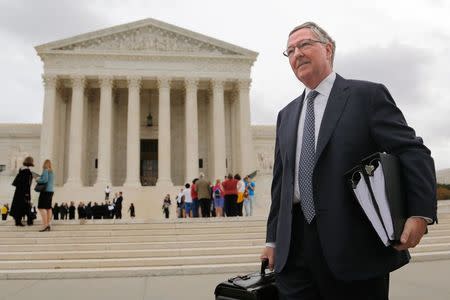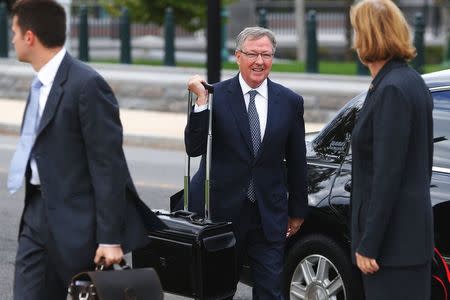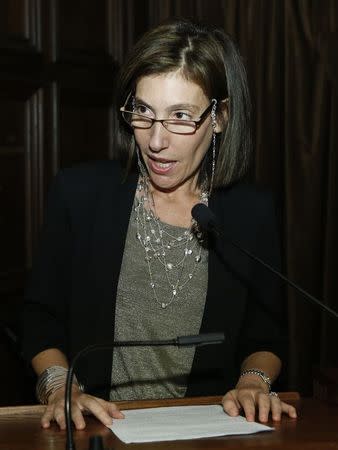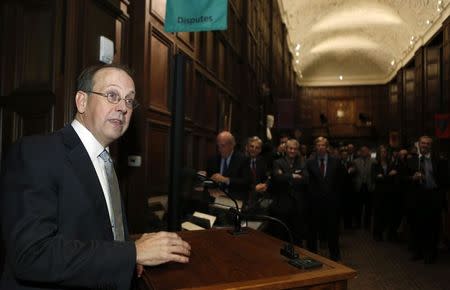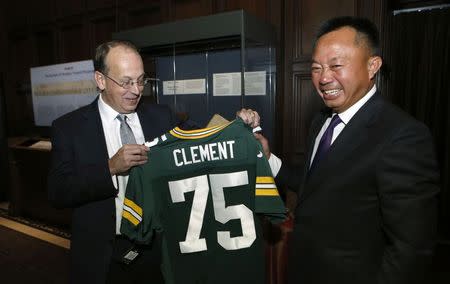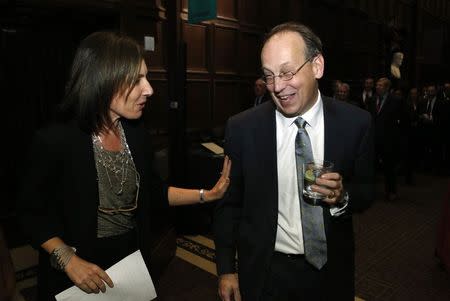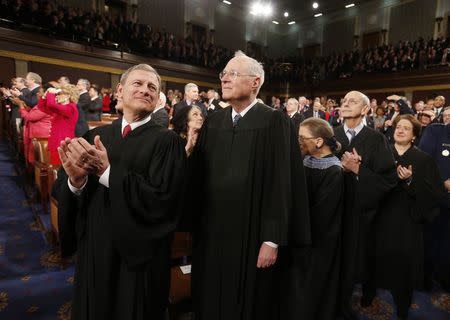Special Report: In ever-clubbier bar, eight men emerge as Supreme Court confidants
By Janet Roberts, Joan Biskupic and John Shiffman WASHINGTON (Reuters) - About 30 seconds into an appearance before the U.S. Supreme Court this fall, lawyer Paul Clement was interrupted by a question. It came from Justice Elena Kagan, and it cut to the heart of his case. But during Clement’s response, another justice jumped in: his former boss, Justice Antonin Scalia. He suggested a different answer to the question that his fellow justice had posed. Clement, once a clerk for Scalia, took the cue. “You could definitely say that, Justice Scalia.…” “You could not only say it,” Scalia replied, “it seems to be true.” “Well, all the better, then,” Clement said, drawing light laughter from the usually reserved audience. The exchange illustrates the familiarity that distinguishes a handful of lawyers from more than a thousand other attorneys who have appeared before the Supreme Court during the past two decades. Previous stories in this series explored how five dozen top lawyers and their firms have enjoyed remarkable success at persuading the high court to accept their clients’ appeals. But an even smaller, more elite group of attorneys, including Clement, has come to dominate the final phase of a case: the oral arguments. That phase, a direct give-and-take with the justices, is an attorney’s last chance to sway the decision. A knack for connecting with the justices is crucial. A Reuters analysis of high court records shows that a group of eight lawyers, all men, accounted for almost 20 percent of all the arguments made before the court by attorneys in private practice during the past decade. In the decade before, 30 attorneys accounted for that same share. In this ever more intimate circle, lawyers say, chemistry with the court is key. The October case was a milestone for the 48-year-old Clement: It marked the 75th time he had appeared before the high court, second most among active lawyers in private practice. The following week, at a party celebrating the feat, veteran attorney Lisa Blatt toasted Clement’s success. “The justices love Paul,” Blatt declared. “They visibly relax when Paul stands up and they are smiling when he sits down.” TEEING UP A CASE In exclusive interviews, many of the justices acknowledge the growing specialization of the Supreme Court bar, and they largely welcome it. They speak glowingly of the repeat performers, explaining that elite lawyers help them understand and sift through complex legal issues. “The problem is when you have a tough case, you need really good lawyers to tee it up, to make the best arguments,” said Justice Clarence Thomas. “That’s what you are looking for.” A lawyer’s arguments can affect the outcome – not often, but often enough, said Justice Anthony Kennedy. The swing vote in many high-profile cases, Kennedy said a lawyer can change minds by framing a case or issue in ways the justices hadn’t considered. “I go in with an inclination, underscore inclination,” Kennedy said. “Not a two-week sitting goes by that a justice doesn’t say, ‘I went in with this idea,’” and then heads in a different direction. As retired Justice John Paul Stevens explained, “They earn respect by their performances. And because they have respect, they are more successful. I am not aware of any downside.” Charles Ogletree, a professor at Harvard Law School, disagrees. “I think that hearing different voices, from more women and people of color, would change the way the court looked at cases and analyzed them,” Ogletree said. No matter; the club is only growing tighter. In the last term alone, 53 percent of the cases the court heard featured at least one lawyer – in government service or private practice – who had clerked for a sitting justice. That’s three times more often than 20 years earlier, Reuters found. The eight lawyers who have appeared most often before the court have especially deep connections to justices past and present. All but one have worked in the powerful U.S. Solicitor General’s office (whose lawyers are constantly at the court representing the federal government), or for a justice as a law clerk, or both. Justice Stephen Breyer values their understanding of how the high court operates. “The Supreme Court is not the CIA,” Breyer said. “I want people to know how the court works.” The eight advocates have represented a varied clientele. Lawyer Ted Olson not only advocated for George W. Bush in Bush v. Gore but also on behalf of same-sex marriage. Attorney Seth Waxman has represented Bank of America and death-row inmates. Gregory Garre defended the University of Texas’ affirmative action policy. And David Frederick won a judgment from pharmaceutical maker Wyeth for a woman who lost an arm to gangrene after taking an anti-nausea drug. But like Clement, this group as a whole primarily represents corporate America. In the last 10 years, Reuters found, half of their arguments were for businesses. FRIENDS OF THE COURT The connections between justice and lawyer extend beyond the courtroom and into social life. Olson is perhaps the best known of the elite. After helping Bush win the 2000 election case, he became the new president’s first solicitor general. Olson returned to private practice and in 2010 prevailed in the Citizens United decision, which allows corporations and labor unions to spend unlimited amounts of money on political campaigns. So familiar is Olson that justices referred to him by his first name in interviews. As Thomas put it, “You want to hear what Ted has to say.” When Olson married in 2006, Justice Kennedy and retired Justice Sandra Day O’Connor were among the guests at the ceremony in Napa Valley, California. Olson and Scalia regularly attend an intimate New Year’s Eve dinner. The location: Justice Ruth Bader Ginsburg’s apartment at the Watergate complex. Last year, Kagan went, too. Another prominent lawyer, Carter Phillips, has remained friends with Justice Samuel Alito since the two worked in the solicitor general’s office in the 1980s. Phillips is the only attorney in private practice who has appeared more often before the Supreme Court than Clement. Two other leading Supreme Court advocates, Waxman and Blatt, appeared in a Shakespeare Theatre Company mock trial of Coriolanus last year, co-starring justices Ginsburg, Breyer and Alito. Waxman, a U.S. solicitor general during the Clinton administration, often crosses path with Scalia, too. When a C-SPAN host once asked Scalia about a jocular exchange the justice had with Waxman during an oral argument, Scalia responded matter-of-factly. “I know Seth,” he said, “and consider him a friend.” Law professors say such relationships should be of little concern. “It’s true of every court where people specialize, and people who specialize are going to become familiar to the judges,” said Steven Lubet of the Northwestern University Law School. But while all other federal judges have policies on socializing with lawyers, Lubet said, the top court does not. “The U.S. Supreme Court, because it has never set any standard like that, basically is saying, ‘Trust us,’” Lubet said. “I don’t think anyone is doing anything wrong, but it would be good to know.” RECUSAL RARE Justices rarely disqualify themselves from cases. When they have done so, it was usually for financial reasons – such as owning stock in a corporation appearing before the court – not social ones. No specific rules govern friendships between justices and those who come before the court. And in the past, the justices have considered their social lives to be largely irrelevant. In 1942, Supreme Court Justice Robert Jackson spent a weekend with President Franklin D. Roosevelt in the Virginia countryside. The next month, Jackson heard a major court case about the administration’s powers, and later wrote the opinion that favored the president. In 1963, Justice Byron White went skiing in Colorado with Attorney General Robert Kennedy. A few weeks later, Kennedy personally argued a case before White and the other justices. “I see nothing wrong with Justice White’s and Justice Jackson’s socializing,” Scalia wrote in an unusual 2004 memorandum, citing those trips when he himself was under scrutiny. Friendships shouldn’t trigger automatic recusals, he said. Scalia’s comments came after he took a duck-hunting trip with Vice President Dick Cheney. The court was considering a case in which environmentalists sought records from an energy committee led by Cheney. After the trip, the Sierra Club called on Scalia to recuse himself. He declined. Recusal should be rare, Scalia said, because justices who bow out cannot be replaced, and those appealing to the high court may be disadvantaged: With only eight remaining on the bench, it becomes harder to secure four votes necessary to get the court to take a case, and later, five votes needed to win a decision. “A rule that required members of this court to remove themselves from cases in which the official action of friends were at issue would be utterly disabling,” Scalia said. Richard Painter, a University of Minnesota law professor, agrees that a strict rule would be a bad idea. A crafty lawyer could find ways to bump a particular justice. “If there’s too much made of these recusals, you can game the system,” he said. SPEAKING THE LANGUAGE The Supreme Court’s culture changes over time, and the court of Chief Justice John Roberts has developed its own character. No matter their political leanings, today’s justices are temperamentally more suited toward technical arguments than sweeping philosophical statements, says Evan Caminker, a University of Michigan law professor. Attorneys who want to win should play to such inclinations, he says. “It becomes more important that you speak their language,” said Caminker. A strong defender of a specialized bar, lawyer Clement says that’s what he does with the justices, translating technical statutes or difficult constitutional questions. He does so succinctly and without notes, a combination that distinguishes him from most of the lawyers who argue before the high court. “There are definite ways that the justices want their questions answered,” Clement said. “If you know that, you can tailor your answers and presumably have better effect.” In his spare time, Clement listens to tapes of lawyers arguing before previous courts. He said he’s amazed at how different the Roberts court is from its predecessors, especially in terms of the rapid-fire questions from the bench and the justices’ interest in the technical intricacies of a case. “I’ve grown up with this court,” Clement said. “To me it’s natural: The art of Supreme Court advocacy is going to be the art of answering questions, as opposed to giving grand speeches.” That inside knowledge, say attorneys who aren’t a part of the elite specialty bar, can be crucial in gaining access to the nation’s highest court. Consider the case brought to the Supreme Court in 2010 by Pennsylvania attorney Robert Goldman. A former federal prosecutor, Goldman had 30 years of trial experience, including handling complex international arms smuggling cases. But as Goldman faced a Supreme Court deadline, he was struggling to write a cert petition for his client, a woman convicted of trying to poison her husband’s pregnant paramour. On a Friday afternoon, five days before the petition was due, he received a call from an associate of Clement. Would Goldman be interested in having Clement argue the case on his behalf? “Mama didn’t raise no fool,” Goldman said. “I put my ego aside for the client.” Clement helped draft the briefs, and he argued the case. They won 9-0, and the decision overturned the woman’s conviction and six-year sentence. ‘WE NEED A HEAVY HITTER’ Michael Costello, a Michigan insurance company lawyer, made the same calculation in a civil rights case. Two policy holders – New Jersey counties that operated jails – were defending a practice of strip-searching people detained for even minor offenses. Costello’s insurance company would be on the hook for any damages. He recalled a colleague’s advice as the case headed to the Supreme Court in 2011. Their opponents had already hired appellate specialist Thomas Goldstein, one of the eight lawyers who has appeared before the court most frequently. Goldstein was working with Stanford Law School professor Jeffrey Fisher, another of the eight. “They’ve got a heavy hitter,” Costello’s colleague told him. “We need a heavy hitter.” Costello hired Phillips, the lawyer who has appeared most often before the high court in private practice. He won on a 5-4 vote. Labor, consumer and civil rights advocacy groups traditionally have sought to put forth an attorney who shares their ideology. But they, too, have begun to turn to specialists. For a case this year, the Service Employees International Union hired Paul Smith of Jenner & Block, a former Supreme Court clerk. The union lost, but not as badly as it feared. The rise of the Supreme Court specialty bar is not universally embraced by the profession. But it is by the justices. Two, in particular, lamented the refusal of some criminal defense lawyers to turn over high court cases to specialists. “It is as if they are arguing with one hand tied behind their back,” Kagan said. Said Justice Sonia Sotomayor: “I think it’s malpractice for any lawyer who thinks this is my one shot before the Supreme Court and I have to take it.” Last year, leading criminal defense attorneys unsuccessfully urged one trial lawyer to relinquish a capital case. If San Antonio lawyer and Supreme Court novice Warren Wolf lost the case, they worried, it could create a harmful precedent for others on death row in Texas. “People said, ‘You’ll ruin it for everybody,’” Wolf recalled. Wolf declined to step aside. But he accepted the help of Waxman, a former solicitor general who has also defended death row inmates pro bono. In the well of the Supreme Court, Waxman sat close to Wolf as the Texas attorney debuted at the lectern. Sometimes, Waxman passed Wolf notes. Two justices appeared piqued when Wolf did not directly answer their questions. Wolf, with an assist from Waxman, won a 5-4 decision for his client. “I owe a lot to a lot of people,” Wolf said afterward, “but ultimately, I’m the guy who stood up there and did it.” St. Louis lawyer Bob Marcus also got help from a top Supreme Court lawyer. In 2011, he recalled, his firm was preparing a Supreme Court brief on behalf of an injured railroad worker against CSX. That’s when he received a call from Frederick, one of the few top lawyers who will oppose big business before the court. Marcus had received offers for help from other lawyers and declined. But none matched Frederick’s stature. The brief was due in about a week. “The best three words I heard in the entire case came during that call,” Marcus said. “And they were David Frederick saying, ‘I’ll do it.’” Marcus said Frederick quickly redrafted the brief in a way “that took it to a whole new level.” They won the case on a 5-4 decision. But what also impressed Marcus is what happened in the minutes before the oral argument. Waiting in a lounge outside the Supreme Court chamber, Marcus watched Frederick chat amicably with a casually dressed woman he did not recognize. Shifting nervously as he anticipated the biggest case of his life, Marcus asked Frederick about the hallway encounter. “Who was that woman?” he wondered. “Oh,” Frederick answered matter-of-factly, “that was Justice Alito’s wife.” (Reporting By Janet Roberts, Joan Biskupic and John Shiffman.; Edited by Blake Morrison and Amy Stevens)

